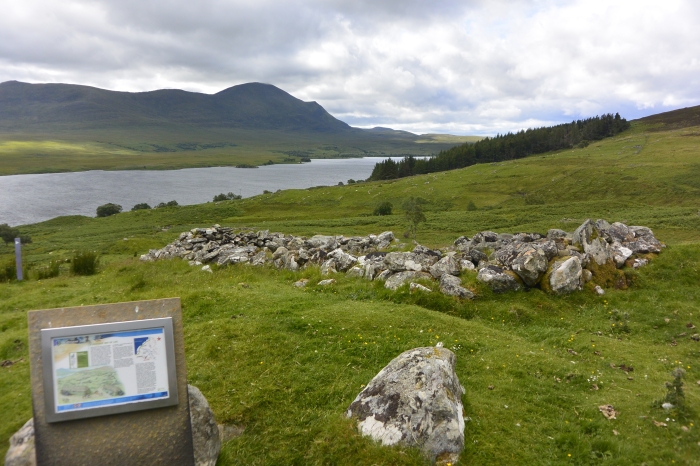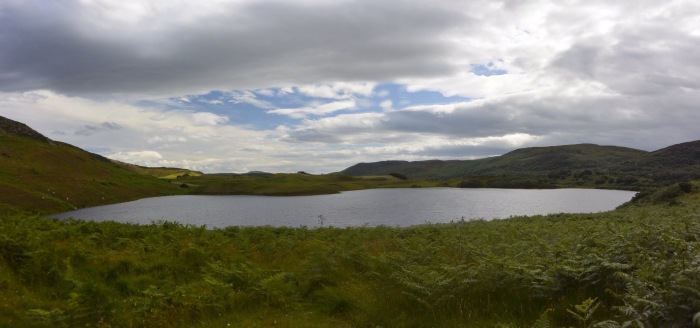East of Tongue
After our Orkney adventure, we made the short ferry crossing from Stromness to Scrabster on the north coast of mainland Scotland. We were heading west to Tongue for a few nights, but stopped off on the way for a walk out to Strathy Point.
This was all familiar territory too. Last time we stayed in Tongue we walked out to Castle Varrich, but this time we merely admired it from afar as we arrived.
Our accommodation was impressive – the Tongue Hotel is a former sporting lodge, built in the late 1800s for the Duke of Sutherland, with many original features.
After a good night’s sleep, we awoke to what can only be described as a dreich day, so we decided to follow the Strathnaver Trail by car. This 24-mile loop east of Tongue, on mostly single track roads, passes historical sites from the Neolithic, Bronze and Iron Ages as well as from the more recent (1800s) Highland Clearances. There’d be plenty of scope for short walks if we got any dry spells in the weather.
We decided that, as the prehistoric sites were unlikely to compare well in standard with what we had just seen in Orkney, we’d concentrate on the 19th century remains. Unfortunately, the tourist board leaflet we had was prepared in 2003 and I’m not sure there had been much maintenance since, as some of the sites were hopelessly overgrown. However, we enjoyed it all the same.
There was a grand view to start with at Braetongue:

The first of the day’s clearance villages was Grummore. This settlement was emptied of its people in the early 19th century to clear ground for sheep farming. Some inhabitants were resettled on the coast and expected to take up sea fishing, even though they had no experience of this. Others moved away to Glasgow or further afield to England, America, Canada, Australia and New Zealand. Maybe some were your ancestors?

Clearances happened all over the Highlands, but the Strathnaver ones have been particularly well documented through the writings of Donald Macleod who witnessed them. His monument is another sight on the tour.
The other clearance villages we visited were Rosal and Achanlochy. The first could allegedly be reached via a forest trail which had so many fallen trees that we had to turn back, though we did get there eventually via the forestry road. The second had so much bracken that you couldn’t see the ruins, but the setting was beautiful; not that this would be much compensation for the hardship of a crofting life and the sheer injustice of being evicted for sheep. The mass exodus of people has disturbing parallels in our own time. How much have we progressed?

Other sights included the rather sweet corrugated iron church at Syre….
….and Bettyhill with its splendid war memorial and the Farr Stone, an 8th century Christianised Pictish stone.
As you can see, by the end of the trail at Bettyhill the sky was a brilliant blue again and we had high hopes for good weather the next day as we ventured west of Tongue.

























![Top-20-Travel-Blogs-200×150[1]](https://i0.wp.com/www.holiday365.co.uk/blog/wp-content/uploads/2012/06/Top-20-Travel-Blogs-200x1501.png)
Gorgeous scenery! I particularly like the Grummore photo, though I’m not sure why that one strikes me more than the others. I think it’s because I’d love to walk there.
LikeLike
Yes, I like that one too.
LikeLiked by 1 person
I just love the sweet little corrugated iron church, it’s so lovely 🙂
LikeLike
Yes, it is! We were very stuck by it.
LikeLike
Such beautiful scenery Anabel! It is so sad to think of the the poor folk who were forced off their lands. I have Scottish ancestry on my father’s maternal side (Maxwells – all the sons in the family have Maxwell as their second name as a honour to that heritage). I know they were reputed to have come from the highlands (they had huge families so there are many descendants and a distant cousin in Canada has done the family tree). My 3 x (I think!) gt grandfather came down to London in the late 18th century and I traced his father back to Perth in Scotland where he was the customs and exercise officer (though he had married in South West Scotland in the Dumfries area). So not sure if they were affected by the clearances or not. Love looking at your beautiful photos 🙂
LikeLike
Thank you. It is absolutely shocking that people were treated like that. Your family history is interesting – I only know about mine back to the mid 19C which I’ve pieced together from documents my parents had. I’d like to know more but don’t fancy the work involved. Now a cousin who researched it for me would be really handy!
LikeLiked by 1 person
It is a lot of work Anabel though you can do a lot online too these days. However I believe the Canadian cousin (my 3rd once removed I think!) did it all with good old fashioned research, which must have taken hours and hours!
LikeLiked by 1 person
Impressive accommodations indeed. So much beauty and greenery and history in the place. The cooler weather would work for me, as I am tired of the oppressive heat here, even well into October. Scotland is gorgeous.
LikeLike
Thank you! Cooler is great – when it stays dry……
LikeLike
What a grand adventure! That little corrugated iron church is just beautiful.
LikeLike
It is. What you can’t see is the sheep sh*t you had to wend your way through to get there! Country joys.
LikeLike
You have visited so many places this year,each one steeped in history.
LikeLike
That’s true! I love historical sites so we always seek them out.
LikeLike
More beautiful photos.
I love that picture of Grummore 🙂
LikeLike
Thanks – would be beautiful place to live. In a cosy cottage.
LikeLike
I see the name Tongue is from the Scottish Gaelic ‘Tunga’ which I definitely prefer. 🙂 What a magical place, Anabel.
LikeLike
Top marks for homework! My view of the word tongue is always coloured by the memory of having to eat the meat as a student and hating it. Tunga definitely sounds more appealing.
LikeLiked by 1 person
Oh yes, I also remember Sunday teatime with ham, tongue and salad. I always took the tiniest piece of tongue. 😳
LikeLike
Nasty taste!
LikeLike
I am still having to get used to a place called Tongue:) There is such loveliness in these pictures even without all the trees (in some pics) and the age of the place-wow. Love the old Farr stone
LikeLike
Yes, it’s definitely a weird name for a place! It’s lovely but lonely – these villages would have been teeming with life at one time.
LikeLike